2014人教版九年级英语unit6 When was it invented重点知识点讲解及练习
- 格式:doc
- 大小:49.50 KB
- 文档页数:4

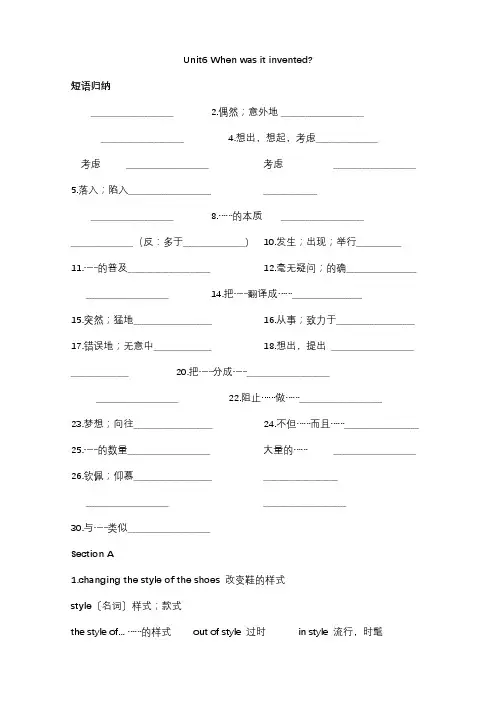
Unit6 When was it invented?短语归纳____________________ 2.偶然;意外地 ________________________________________ 4.想出,想起,考虑_______________考虑____________________ 考虑____________________ 5.落入;陷入____________________ _________________________________ 8.……的本质___________________________________(反:多于_______________) 10.发生;出现;举行___________ 11.……的普及____________________ 12.毫无疑问;的确_____________________________________ 14.把……翻译成……_________________15.突然;猛地___________________ 16.从事;致力于___________________ 17.错误地;无意中______________ 18.想出,提出____________________ ______________ 20.把……分成……________________________________________ 22.阻止……做……____________________23.梦想;向往___________________ 24.不但……而且……__________________25.……的数量____________________ 大量的……____________________26.钦佩;仰慕___________________ ______________________________________ ____________________30.与……类似____________________Section A1.changing the style of the shoes改变鞋的样式style〔名词〕样式;款式the style of... ……的样式out of style 过时in style 流行,时髦The style of the blouse is my mother's favorite.2.—Can you help me think of an invention?你能帮我想个发明吗?—With pleasure!乐意效劳!1) Can you do...?你能做……吗?此句型表示客气地请求某人做某事,其肯定回答一般为“Sure, I'd love/like to./With pleasure.”。

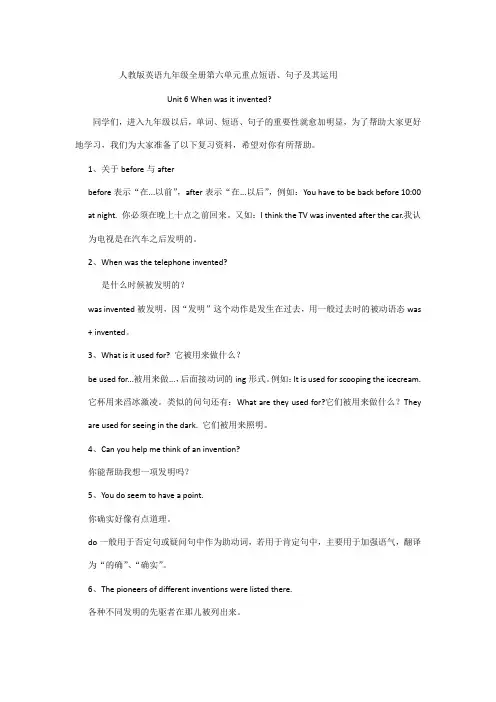
人教版英语九年级全册第六单元重点短语、句子及其运用Unit 6 When was it invented?同学们,进入九年级以后,单词、短语、句子的重要性就愈加明显,为了帮助大家更好地学习,我们为大家准备了以下复习资料,希望对你有所帮助。
1、关于before与afterbefore表示“在...以前”,after表示“在...以后”,例如:You have to be back before 10:00 at night. 你必须在晚上十点之前回来。
又如:I think the TV was invented after the car.我认为电视是在汽车之后发明的。
2、When was the telephone invented?是什么时候被发明的?was invented被发明,因“发明”这个动作是发生在过去,用一般过去时的被动语态was + invented。
3、What is it used for? 它被用来做什么?be used for...被用来做...,后面接动词的ing形式。
例如:It is used for scooping the icecream.它杯用来舀冰激凌。
类似的问句还有:What are they used for?它们被用来做什么?They are used for seeing in the dark. 它们被用来照明。
4、Can you help me think of an invention?你能帮助我想一项发明吗?5、You do seem to have a point.你确实好像有点道理。
do一般用于否定句或疑问句中作为助动词,若用于肯定句中,主要用于加强语气,翻译为“的确”、“确实”。
6、The pioneers of different inventions were listed there.各种不同发明的先驱者在那儿被列出来。
were listed被列出来,一般过去时的被动语态。



Unit6 When was it invented?An Accidental InventionDid you know that tea, the most popular drink in the world (aft er water), was invented by accident? Many people believe that tea was first drunk nearly 5,000 years ago. It is said that a Chinese ruler called Shen Nong first discovered tea as a drink. One day Shen Nong was boiling drinking water over an open fire. Some leaves from a tea plant fell into the water and remained there for some time. It produced a nice smell so he tasted the brown water anyway. It was quite delicious. In this way, one of the world’s favorite drinks was invented.A few thousand years later, Lu Yu, “the saint of tea”, mentioned Shen Nong in his book Cha Jing. The book describes how tea plants were grown and used to make tea. It also discusses where the fi nest tea leaves were produced and what kinds of water were used.It is believed that tea was brought to Korea and Japan during the 6th and 7th centuries.In England, tea didn’t appear until around 1660, but less than 100 years later,it had become the national drink. The tea trade from China to Western countries took place in the 19th century. This helped to spread the popularity of tea and the tea plant to more places around the world. Even though many people now know about tea culture, the Chinese are without doubt the ones who best understand the nature of tea.。
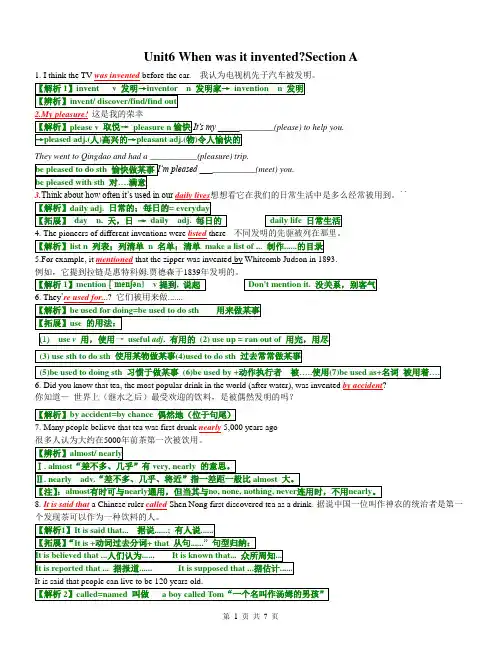
Unit6 When was it invented?Section A1. I think the TV was invented before the car. 我认为电视机先于汽车被发明。
【解析1】invent v 发明→inventor n 发明家→invention n 发明【辨析】invent/ discover/find/find out2.My pleasure!这是我的荣幸【解析】please v 取悦→pleasure n愉快.It’s my _____________(please) to help you.→pleased adj.(人)高兴的→pleasant adj.(物)令人愉快的They went to Qingdao and had a ___________(pleasure) trip.be pleased to do sth 愉快做某事I’m pleased _____________(meet) you.be pleased with sth 对….满意3.Think about how often it’s used in our daily lives想想看它在我们的日常生活中是多么经常被用到。
``【解析】daily adj. 日常的;每日的= everyday【拓展】day n. 天,日→daily adj. 每日的daily life 日常生活4. The pioneers of different inventions were listed there 不同发明的先驱被列在那里。
【解析】list n 列表;列清单n 名单;清单make a list of ... 制作......的目录5.For example, it mentioned that the zipper was invented by Whitcomb Judson in 1893.例如,它提到拉链是惠特科姆.贾德森于1839年发明的。
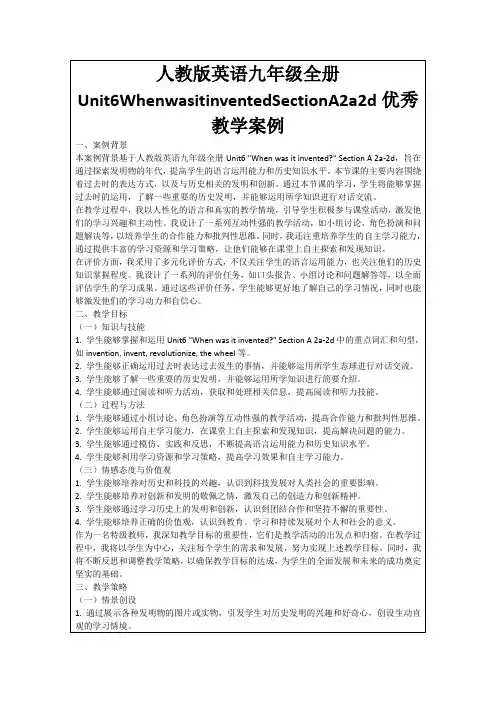
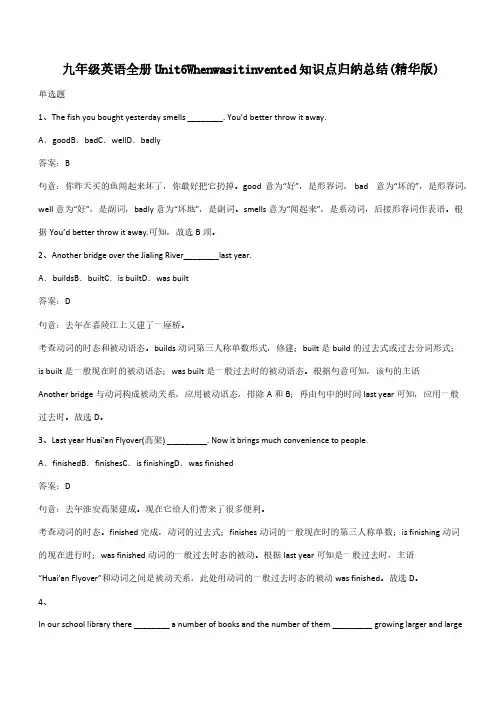
九年级英语全册Unit6Whenwasitinvented知识点归纳总结(精华版)单选题1、The fish you bought yesterday smells ________. You’d better throw it away. A.goodB.badC.wellD.badly答案:B句意:你昨天买的鱼闻起来坏了,你最好把它扔掉。
good意为“好”,是形容词, bad 意为“坏的”,是形容词,well意为“好”,是副词,badly意为“坏地”,是副词。
smells意为“闻起来”,是系动词,后接形容词作表语。
根据You’d better throw it away.可知,故选B项。
2、Another bridge over the Jialing River________last year.A.buildsB.builtC.is builtD.was built答案:D句意:去年在嘉陵江上又建了一座桥。
考查动词的时态和被动语态。
builds动词第三人称单数形式,修建;built是build的过去式或过去分词形式;is built是一般现在时的被动语态;was built是一般过去时的被动语态。
根据句意可知,该句的主语Another bridge与动词构成被动关系,应用被动语态,排除A和B;再由句中的时间last year可知,应用一般过去时。
故选D。
3、Last year Huai'an Flyover(高架) _________. Now it brings much convenience to people. A.finishedB.finishesC.is finishingD.was finished答案:D句意:去年淮安高架建成。
现在它给人们带来了很多便利。
考查动词的时态。
finished完成,动词的过去式;finishes动词的一般现在时的第三人称单数;is finishing动词的现在进行时;was finished动词的一般过去时态的被动。
![[笔记]九年级英语Unit6课文翻译](https://uimg.taocdn.com/79acb72482c4bb4cf7ec4afe04a1b0717fd5b34b.webp)
Unit6 when was it invented ?Section A 2d保罗:嘿,罗伊,这次我们学校的项目任务的主题是“改变世界的小发明”。
你能帮我想一个小发明吗?罗伊:我很乐意!让我想想…..嗯……有啦!拉链!保罗:拉链?它真是这样一项了不起的发明吗?罗伊:想想在我们的日常生活中会多么频繁地使用它吧。
你能看见拉链在裙子、裤子、鞋子、背包上…..无处不在!保罗:嗯,看来你说的确实有道理…….罗伊:当然!我想到它是因为我上周看到一个网站。
不同发明的创始者都被列在上面。
比如说,它提到拉链是在1893年被惠特科母.贾德森发明的。
不过那时候它并没有被广泛使用。
保罗:真的吗?那它是什么时候流行起来的。
?罗伊:1917年左右。
Section A 3a一项偶然的发明你知道茶,作为世界上最受欢迎的饮料(仅次于水),是一项偶然的发明吗?许多人都认为在5000年以前就开始了饮茶。
据说一位叫神农的中国统治者最早发现茶可以引用。
一天,神农在户外的炉火上烧水,茶树上有几片叶子掉入水里,过了一会,散发出怡人的香味,于是神农品尝了这褐色的水,它非常香醇,就这样,世界上最受欢迎的饮料之一被发明了。
数千年后,“茶圣”陆羽在他的《茶经》一书中提到了神农。
该书描述了如何种植茶树和泡茶,它还讨论了什么地方出产最好的茶叶,而且还应该使用什么样的水来泡茶。
人们认为茶是在公元6-7世纪传播到日本和朝鲜。
在英国,大约直到1660年才发现,但不到100年的时间里,茶已经成为国饮。
从中国到西方的茶叶贸易始于19世纪。
这使得茶树和茶叶传播到世界更多地方,使之深受欢迎。
虽然现在又许多人都了解一些茶文化,但毫无疑问的是,中国人才是最了解茶之本质(精髓)的人。
Section B 2b你知道篮球是什么时候发明的吗?篮球是一项许多人都喜爱的积极运动,它既有趣有健身。
篮球有100多年的历史,而且有200多个国家,超过10亿人都在玩篮球。
普遍认为1891年地12月12日是历史上第一场篮球比赛的日子。
人教版九年级英语《Unit 6 When was it invented?》Section A教学设计2一. 教材分析人教版九年级英语《Unit 6 When was it invented?》Section A主要介绍了与发明物相关的动词短语和一般过去时的被动语态。
本节课的主要内容包括三个部分:阅读文本、听力练习以及口语交流。
通过本节课的学习,学生能够掌握与过去相关的被动语态的运用,以及学会如何运用动词短语描述事物的发明时间。
二. 学情分析九年级的学生已经掌握了英语学习的基本语法和词汇,具备一定的阅读和听力能力。
但是,对于一般过去时的被动语态和与发明物相关的动词短语的运用,部分学生可能还存在一定的困难。
因此,在教学过程中,需要针对学生的实际情况进行针对性的教学。
三. 教学目标1.知识目标:学生能够掌握一般过去时的被动语态,以及与发明物相关的动词短语。
2.能力目标:学生能够运用所学的动词短语和被动语态进行简单的口语交流和写作。
3.情感目标:通过学习,学生能够增强对科技发展的兴趣和好奇心。
四. 教学重难点1.重点:一般过去时的被动语态的运用。
2.难点:与发明物相关的动词短语的运用。
五. 教学方法1.任务型教学法:通过设计各种任务,让学生在实践中学习和运用语言。
2.情境教学法:创设各种情境,让学生在真实的语境中学习和运用语言。
3.交际法:通过小组讨论和角色扮演等方式,让学生进行真实的交际。
六. 教学准备1.教师准备:备好相关的教学材料,如PPT、教案等。
2.学生准备:预习相关的词汇和语法知识。
七. 教学过程1.导入(5分钟)通过展示一些常见的发明物,如手机、电视等,引导学生谈论这些发明的出现时间,引出本节课的主题。
2.呈现(10分钟)通过PPT展示本节课的主要内容,包括一般过去时的被动语态和与发明物相关的动词短语。
让学生边看PPT边跟读,加强记忆。
3.操练(15分钟)设计一些简单的口语练习,让学生运用所学的动词短语和被动语态进行练习。
人教版九年级英语《Unit 6 When was it invented?》说课稿一. 教材分析人教版九年级英语《Unit 6 When was it invented?》是本单元的第一课时,主要讲述过去时态的疑问句以及一般过去时的被动语态。
本节课主要通过介绍一些发明的起源时间,让学生掌握过去时疑问句的构成以及一般过去时的被动语态的运用。
教材内容丰富,插图生动有趣,激发了学生学习的兴趣。
二. 学情分析九年级的学生已经掌握了基本的英语语法知识,具备一定的阅读和写作能力。
但是,对于过去时疑问句和一般过去时的被动语态的运用还存在一定的困难。
因此,在教学过程中,需要注重引导学生掌握这些语法知识,并通过大量的练习来提高他们的语言运用能力。
三. 说教学目标1.知识目标:让学生掌握过去时疑问句的构成以及一般过去时的被动语态的运用。
2.能力目标:通过听力、口语、阅读和写作的练习,提高学生运用过去时疑问句和一般过去时的被动语态进行交流的能力。
3.情感目标:激发学生学习英语的兴趣,培养他们积极向上的学习态度。
四. 说教学重难点1.教学重点:过去时疑问句的构成以及一般过去时的被动语态的运用。
2.教学难点:一般过去时的被动语态的运用。
五. 说教学方法与手段1.教学方法:采用任务型教学法,通过听力、口语、阅读和写作的练习,让学生在实际语境中掌握过去时疑问句和一般过去时的被动语态的运用。
2.教学手段:利用多媒体课件、图片、卡片等教学辅助工具,激发学生的学习兴趣,提高课堂活力。
六. 说教学过程1.导入:通过展示一些常见的发明图片,引导学生谈论这些发明的起源时间,从而引入本节课的主题。
2.新课呈现:通过多媒体课件,展示本节课的主要内容,引导学生观察并发现过去时疑问句的构成以及一般过去时的被动语态的运用。
3.语法讲解:通过示例和讲解,让学生明确过去时疑问句的构成和一般过去时的被动语态的运用规则。
4.小组讨论:学生分组进行讨论,运用过去时疑问句和一般过去时的被动语态进行交流,巩固所学知识。
Unit6 When was it invented?1、被动语态(1). 被动语态表示句子的主语是谓语动词所表示的动作承受者。
(2). 被动语态基本结构:be+及物动词的过去分词(如果是不用物动词,其过去分词应带有相应的介词)(3). 被动语态中的be 是助动词,有人称、数和时态的变化。
一般现在时被动语态为:am/is/are+过去分词一般过去时被动语态为:was/were+ 过去分词与情态动词连用的被动语态:情态动词+ be + 过去分词(4). 被动语态中动作的发出者或执行者做介词by的宾语,放在句末,by 表示“由,被”的意思2、如何理解被动语态?为取胜更清晰、更深刻地理解被动语态的含义,可以将主动语态和被动语态的句子结构进行比较。
主动语态:其他成分被动语态:+其他成分如:被动语态3. invent v. 发明inventor n. 发明家invention n. 发明可数名词4. be used for doing用来做…(是被动语态) 如:Pens are used for writing. 笔是用来写的。
Pens aren’t used for eating. 笔不是用来吃的。
5. 给某人某样东西give sth. to sb. 如:I gave a pen to him. 我给他一支笔。
give sb. sth. I gave him a pen. 我给他一支笔。
6. by mistake 错误地如:I took the umbrella by mistake. 我不小心拿错了雨伞。
7. make sb./sth. +形容词使…怎么样It made me happy. 它使我高兴make sb./sth. +名词让…做…It made me laugh. 它让我发笑8. not…until…直到…才做…如:I didn’t go to bed until I finished my work.9 quite 非常adv. 与冠词a连用时,冠词a必须放在它的后面如:quite a beautiful girl 一个漂亮的女孩very 非常adv. 与冠词a连用时,冠词a必须放在它的前面如: a very beautiful girl 一个漂亮女孩注:当不与冠词a 连用时,两者可以互用如:I am very happy.=== I am quite happy. 我非常高兴。
Unit6 When was it invented?1、被动语态(1). 被动语态表示句子的主语是谓语动词所表示的动作承受者。
(2). 被动语态基本结构:be+及物动词的过去分词(如果是不用物动词,其过去分词应带有相应的介词)(3). 被动语态中的be 是助动词,有人称、数和时态的变化。
一般现在时被动语态为:am/is/are+过去分词一般过去时被动语态为:was/were+ 过去分词与情态动词连用的被动语态:情态动词+ be + 过去分词(4). 被动语态中动作的发出者或执行者做介词by的宾语,放在句末,by 表示“由,被”的意思2、如何理解被动语态?为取胜更清晰、更深刻地理解被动语态的含义,可以将主动语态和被动语态的句子结构进行比较。
主动语态:其他成分被动语态:+其他成分如:3. invent v. 发明inventor n. 发明家invention n. 发明可数名词4. be used for doing用来做…(是被动语态) 如:Pens are used for writing. 笔是用来写的。
Pens aren’t used for eating. 笔不是用来吃的。
5. 给某人某样东西give sth. to sb. 如:I gave a pen to him. 我给他一支笔。
give sb. sth. I gave him a pen. 我给他一支笔。
6. all day 整天7. salty adj. 咸的salt n. 盐8. by mistake 错误地如:I took the umbrella by mistake. 我不小心拿错了雨伞。
9. make sb./sth. +形容词使…怎么样It made me happy. 它使我高兴make sb./sth. +名词让…做…It made me laugh. 它让我发笑10. by accident 意外偶然I met her by accident at bus stop.11. not…until…直到…才做…如:I didn’t go to bed until I finished my work.12. according to +名词根据…如:according to an legendaccording to this article根据这篇文章根据一个神话13. over an open fire 野饮14. leaf n. 叶子复数形式leaves15. nearby adj. 附近的如:the nearby river16. fall into 落入掉进如:The leaf fell into the river. 叶子落入了河里。
fall down 摔倒如:She fell down from her bike.17. quite 非常adv. 与冠词a连用时,冠词a必须放在它的后面如:quite a beautiful girl 一个漂亮的女孩very 非常adv. 与冠词a连用时,冠词a必须放在它的前面如: a very beautiful girl 一个漂亮女孩注:当不与冠词a 连用时,两者可以互用如:I am very happy.=== I am quite happy. 我非常高兴。
18. in the way 这样19. pleased adj. 表示外部因素引起人发自内心的欣慰和愉快pleasant adj. 愉快高兴指天气、时间、旅行令人高兴愉快please v.使高兴使同意20. battery—operated adj. 电池控制的是名词+动词的运动分词构成的合成形容词21. in the sixth century 在第6世纪22. travel around 周游23. more than === over 超过如:more than 300 == over 300 超过30024. including prep.介词包括可以与名词和动名词连用如: Six people, including a baby, were hurt.25. have been played 被上演是现在完成时的被动语态现在完成时的被动语态的结构:have /has been +过去分词26. be born 出生He was born in Canada. 他在加拿大出生27. safety n. 安全safe adj. 安全的28. knock into 撞上(某人)29. divide sth. into …将…划分成. 通常指将一个整体分成几个对应相对的部分如:Let’s divide ourselves into 4groups. 让我们把我们自己划成4组。
30. since then 自从那以后常与完成时态连用如:Since then, I have left Beijing. 自从那以后,我已经离开了北京。
词义辨析1. create, produce, invent①create指“有目的的把原材料制成新产品”,也指创造出原来不存在或与众不同的事物。
②produce指“通过劳动、加工而生产产品”,尤指“工农业产品”。
③invent 指通过想象,研究,劳动创造出前所未有的东西,尤指“科技上的发明创造”。
1)Bell the telephone.2)This field rice.3)People in Western countries believe that God the world.2.below, under①below与above相对,指“在….的下方”,表示一件东西的位置低于另一件东西,但不一定在另一件东西的正下方。
②under与over相对,表示的范围较窄,表示一件东西的位置垂直在另一件东西下边。
1)There are some books the desk.2)All the fields are the plane.3.raise, rise①raise的意思是“提高”、“举起”,是及物动词,既能接宾语,也能用于被动语态。
它的宾语一般是头、手、眼、帽、重物以及政治觉悟、生活水平、物价、温度、声音等。
此外,raise有“饲养、供养”的意思。
raise-raised-raised②rise的意思是“上升”、“上涨”,是不及物动词,既不能接宾语,也不能用于被动语态。
它的主语一般是日、月、云、烟、热、气、温度计、物价、河水等。
指人时,一般指人“站起”、“起床”。
rise--rose--risen1)He his voice and shouted.2)The price has .3) These families may children as their chief occupation.(主要职业)4.the number of, a number of①the number of 意为“…的数量,数目”,of后常接名词复数形式,在句中作主语时动词要用单数形式。
②a number of意为“许多的”,相当于many,number前可用large, small修饰,表示程度。
作主语时,谓语动词用复数形式。
1)The number of boys in our class (be)twenty-two.2)A number of girls (have)long hair.单项选择1. Look at the sign on the right.-Oh, parking here.A. doesn’t allowB. isn’t allowedC. didn’t allowD. wasn’t allowed2.It is that he’ll come here.A. sayB. supposedC. believeD. expect3.- boys come to swim. Do you know of them?A. A number of, a numberB. The number of, a numberC. The number, numbers ofD.A number of, the number4.We should take an part in after-school activities.A. activeB. ActivityC. activelyD. inactive5.The house-price keeps all the time in recent years.A. goingB. risingC. raisingD. lifting6.China is a country. Japan is a country.A. developed, developingB. developing, developedC. development, developingD. develops, develop7. Yesterday Li Ping knocked a big tree.A. intoB. inC. onD. onto8. We are going to divide the class small groups.A. toB. inC. of D .into9. Everyone knows Thomas Edison ________a lot of useful inventions.A. inventsB. inventedC. discoversD. discovered10. He lived in place __________ Gum Tree.A. calledB. nameC. namedD. Both A and C11. _____ is believed that Bell invented the first telephone in1876.A. ThisB. ThatC. ItD. One12. In his free time, he often teaches me how ________.A. swimB. swimmingC. to swimD. swims13. The number of teachers in our school _____60 and a numberof them ______ male teachers.A. is; areB. are; isC. am; areD. be; are14. Look! A boy is falling the river. Let’s go and save him.A. intoB. overC. downD. off15. The boy to get supper ready after school.A. were toldB. is tellingC. was toldD. tells16. You must practice to become good at it.A. a lot ofB. a lotC. lots ofD. a little用所给词的适当形式填空。